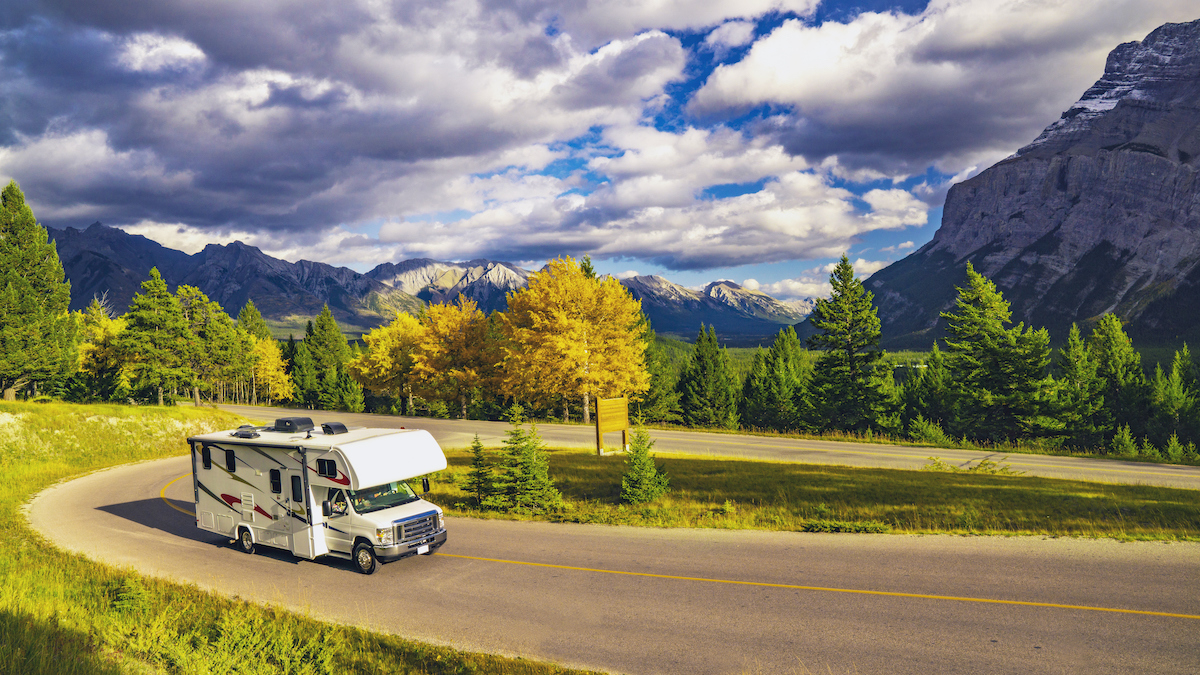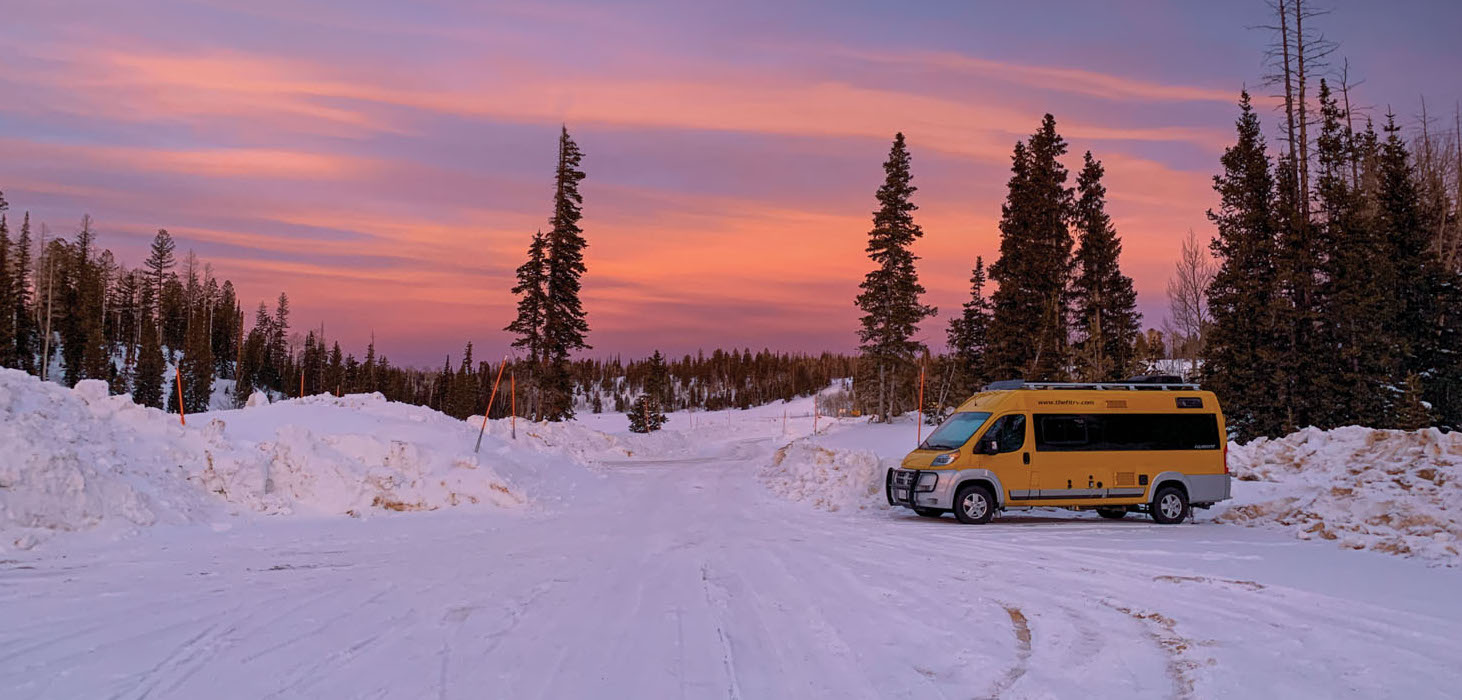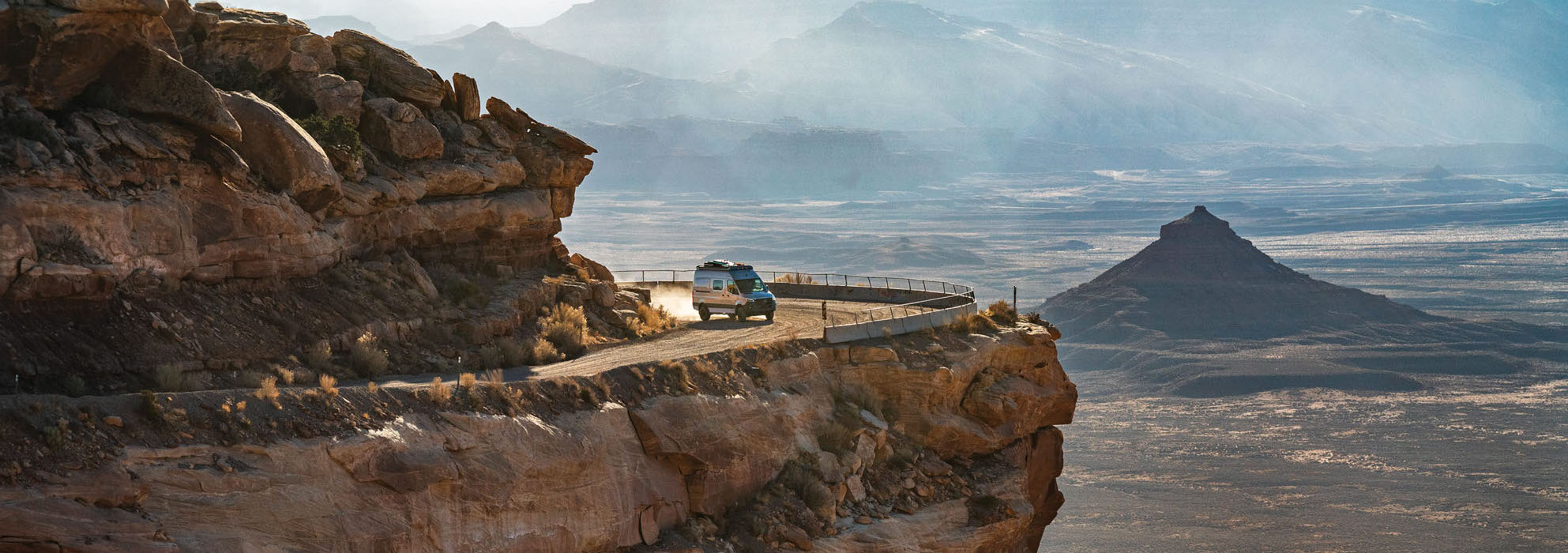Tips for Mountain Driving
With these driving tips and techniques, you can safely tackle the high twisties in your RV.
Image Caption: Photo Courtesy of Getty Images
There are circumstances that can lead to white-knuckle driving when traveling with your motorhome or a truck-and-trailer combo. High, gusty winds; icy road conditions; and being passed by semis and tractor-trailers on rain-soaked curvy roadways can be stressful. But none can be potentially more challenging than driving on high mountain roads.
For here, unlike the other scenarios, you cannot stop and wait it out. Eventually, the winds will ease, the ice will leave, and the rain will stop, but that steep 6% winding grade will still lay ahead regardless. The grade steepness is shown on road signs displaying the percentage of slope. This number indicates the elevation change in feet for every 100 feet of horizontal distance.
Fortunately, there are skills and techniques that can help you tame high-mountain-road challenges and can hopefully turn what could be an uncomfortable feat into a grand scenic tour. After all, many mountain peaks and passes serve some of the best views in the country.
The most common answer you hear from people regarding selecting the right gear to descend a steep mountain grade is, “Use the same gear as you used to climb it.” Great! And what gear would that be? Unless you engage this grade both ways regularly you will have no idea. We certainly need a better strategy than that!
In all grade circumstances be sure to engage the tow rig’s “Tow/Haul” mode when available. This accomplishes a couple of desirable towing features relating to grades. It somewhat modifies the transmission shift points to better match the engine’s horsepower and torque output to handle the load.
Depending on the vehicle model, it also helps the transmission lock into the desired gear when traveling downgrade. For example, when you brake enough to cause a downshift to third gear, the transmission will stay there unless increased engine rpm calls for an upshift to avoid over-revving the engine. Your vehicle’s owner’s manual can explain in detail how Tow/Haul works for your vehicle.
Going Up

Photo Credit: Cavan Images/Getty
Long, steep ascents require plenty of horsepower and torque. This large power draw creates a lot of heat in the engine, transmission, and related components. To manage these temperatures and keep the driveline cooler, climb in a manually selected gear. This will allow partial throttle without the transmission forcing an upshift. Operating at higher rpm circulates the engine coolant and transmission fluid at an increased rate, dispersing heat better.
To attain the gear needed, let the automatic make its selection once the climb is underway. Then shift one gear down to increase the engine speed. Now shift as needed to maintain a high engine revolution at partial throttle. Do not forget to upshift and return to drive mode once the grade has been completed. Let’s take a look at some of the best practiced heavy RV steep grade scaling techniques.
Ascend Grades at a High Constant Engine Speed
This requires that a manual gear be selected to eliminate the transmission from seeking an upshift while a 70% or higher throttle position is held.
Select the Gear Choice
This is accomplished by selecting the highest gear that you can maintain speed while operating at about 80% maximum engine rpm. (Speed subject to driving conditions.)
Monitor the Engine and Transmission Temperatures
Scan the dash gauges with consistency and pay special attention to the engine and transmission temperatures. On vehicles not equipped with transmission temperature status, you can see the combined changes reflected in that of the engine gauge. The transmission heat is managed by an engine coolant heat exchange circuit.
Engine or Transmission Overheat
If overheat warnings sound or the readings indicate reaching a critical point, find the nearest safe pull-off. Once stopped do not shut down the motor. With the brakes applied, shift into Park or Neutral. Increase the engine speed to about 1,200 rpm and monitor the temperature(s). For diesel pushers equipped with the VIP Smart Wheel, the idle speed may be controlled by depressing the Resume or Accelerate cruise buttons while in neutral with the service brakes not applied. Don’t forget to disengage the high idle by tapping the brake pedal before attempting to put the vehicle in Drive. Within a couple of minutes, a cooling trend should be evident.
Patience
Yes, you’ll be going slower up the hill. Yes, on a multilane road vehicles of all types will be passing you headed up the hill. And that’s fine—what’s your rush? You’ll take a few more minutes to crest a multi-mile grade but you’re far better off doing so in a safe manner that’s also the least abusive on your tow vehicle.
Heading Back Down

Image Courtesy of LeonidKos/Getty
Well, as Sir Isaac Newton put it, “What goes up must come down,” so now the descent strategy. You must first understand the challenge. The more weight, the more potential downhill speed. Brakes are not designed to apply lightly to constantly control the speed for long, steep descents. Gasoline engines offer reasonably good driveline resistance, also known as engine compression holdback, as their air intake is closed, making it harder to rotate. Diesel motors have no air intake restrictions, therefore offer far less drag. For this reason, diesel engines require an internal restriction.
The most basic is an exhaust brake, also called a Pacbrake but sold under different names by other manufacturers, that restricts exhaust exiting the manifold to make it harder for the engine to turn over and thus creates engine compression holdback. More complex and generally used on commercial vehicles is a Jake Brake that’s a solenoid-controlled engine-timing mode that changes the motor into a compressor-like action to provide rotational resistance. The latter can be three-stage employing 2, 4, or 6 cylinders to deliver low-, medium-, or high-resistance torque. A less common transmission grade retarder is capable of multi-selection of slowing torque.
To slow, or control one’s speed downhill, you must disperse energy. This can only be done by the creation of heat. For example, using the service brakes can produce tremendous heat, as does the employment of an engine compression brake or transmission retarder. Even wind resistance helps to disperse energy, especially with many RVs having the aerodynamics of a concrete block.
Mastering the Downhill Journey
Preparing for the descent is the first part. Commence reducing speed when you pass the “Steep Grade” sign, taking notice of any further grade information. Shorten up your GPS range so it can help you anticipate the turns and bends ahead. Just as you crest the grade, select a lower gear, engage the engine compression braking system or transmission grade retarder, as applicable.
Know Your Transmission Shift Mapping
Part of maintaining your speed while running downhill requires knowing your vehicle’s programmed shift speeds. This is needed to get the best deceleration from whichever engine compression system is in the rig. The ideal speed would be fully checked by the compression holdback, however, that happens rarely. Usually, the speed will be creeping up. Here you want to apply a firm braking action briefly prior to the automatic upshift.
Generally, the mapped deceleration upshifts are slightly higher than the governed engine speeds. Tip: Find and record the shift points for each gear. On a quiet road, accelerate at full throttle. Note and record the speed at which each gear shifts up. Using some colored-tape small dots, stick them on the speedo at each recorded speed. Now braking at the right point will prevent a surprising automatic upshift.
To make it even easier, many, if not most, modern rigs popular as tow vehicles have manual shift controls for automatic transmissions. As you approach the downgrade, hit the manual gear selection lever or button and tell the vehicle to go no higher than third gear, for example. This holds the transmission at third gear.
If your speed increases to the point that the engine rpm becomes excessive and risks engine damage the system will usually automatically upshift to reduce engine speed. Some braking will then be required to haul the vehicle back down to the desired speed and to shift back to third.
Regulate Speed Using Driveline Resistance
The majority of the speed control should be regulated by varying the driveline resistance (compression braking). For transmission only, shift up and down as needed. Exhaust brakes can be turned on and off as needed to check the downward speed. Jake Brake-equipped vehicles can likewise regulate the resistance to match the needed result. Multi Jake and grade-retarder-equipped units can be switched to maintain the required descent speed.
Do Not Ride or Drag the Service Brakes
The heat of the brake shoes or pads can build quickly if they are ridden during grade descents. This can lead to brake fade and possible failure. Using them in short, firm bursts is effective and allows them to cool.
Once you safely reach the bottom of the grade continue driving at normal speed to cool the brakes. If you stop right away, the portion of the brake discs under the brake pads will cool at a different rate than the rest of the disc that’s in the open. This uneven cooling can warp the brake discs and result in uneven braking thereafter, plus you may feel a rhythmic pulsing of the brake pedal. Drive awhile to cool them and you’ll be fine.
Convey Your Vehicle’s Status to Other Traffic
If you are traveling at a speed much below that of other traffic, whether climbing or descending, employ your flashers to warn others. Also, if you have a diesel pusher with an auxiliary braking system, have the ECM programmed to illuminate the brake lights when engaged if they are not already enabled.
Adjust Speed and Auxiliary Braking to Meet Road Conditions
Caution must be observed if the road surface is wet. Applying a sudden deceleration torque at the drive axle may induce a skid. While it is recommended that auxiliary braking should not be employed on wet or traction-compromised road surfaces, there are techniques that can reduce such loss of traction events.
Applying your auxiliary braking should be at a speed that will result in a relatively low engine rpm engagement. This can be synchronized using the colored hash marks you have added earlier to the speedo. The braking action will then be more moderate during its engagement and will build smoothly as speed increases. However, the actions and assessment of traction on the road surface are entirely up to the operator.
Elevation Environment Changes
Mountain driving exposes you to other challenges in weather-related conditions. Fog or clouds can be present in higher levels or in valley floors. Temperatures can vary greatly with elevation changes. The normal lapse rate of temperature to elevation is 3.5° to 5.4° F per 1,000 feet depending on the humidity. This means a 5,000-foot climb on a 60° F day may encounter icy conditions at the summit, but this kind of result will vary widely.
These are some points that may be helpful when venturing into high grounds. The sights and scenery of mountain adventuring truly make getting there half the fun.





